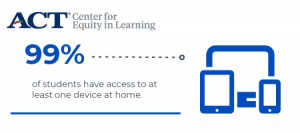
Imagine going to school and being asked to complete a homework assignment that requires you to search for material online and write a brief summary of what you’ve found. However, you only have access to smartphone to do this work; a smartphone you have to share with your sibling who also needs it to do school work. According to research that we have done, this is a very real scenario for many students. The “homework gap” widens with limited access to the appropriate technology. Furthermore, this gap continues to widen as teachers incorporate technology-based learning into their daily curricula.
To date, most research about the digital divide has focused on the U.S. population generally, with less attention paid to determining whether the divide exists among students in the U.S. education system. We conducted a study asking students numerous questions about their access to and use of technology specifically for educational activities, both at home and in school, including the number and kinds of devices they have access to, the kind and reliability of the internet connection(s) available to them, and how often they used electronic devices for school-related activities.
 First, while almost all students have access to technology and the internet at home, the number and type of technological access and internet quality can vary. A total of 14% of students reported having access to only one technological device, and most (85%) of these students were traditionally underserved students. Put differently, there was a relationship between annual family income, parents’ education level, and racial composition with technology access. The higher the family income and the higher parents’ education was the more likely students were to have access to more than one device relative to students who came from families with lower income and less formal education. White and Asian students were also more likely to have multiple technological devices relative to students who self-identified as Hispanic, Black or African American, or American Indian/Alaska Native.
First, while almost all students have access to technology and the internet at home, the number and type of technological access and internet quality can vary. A total of 14% of students reported having access to only one technological device, and most (85%) of these students were traditionally underserved students. Put differently, there was a relationship between annual family income, parents’ education level, and racial composition with technology access. The higher the family income and the higher parents’ education was the more likely students were to have access to more than one device relative to students who came from families with lower income and less formal education. White and Asian students were also more likely to have multiple technological devices relative to students who self-identified as Hispanic, Black or African American, or American Indian/Alaska Native.
Second, the number of devices students had access to is related to how often they use that device for school-related activities. Our research has found students who have access to more than one device are using their devices more frequently than students who have access to only one device, especially those students who have access to only a smartphone. This is important since students need to learn how to use technology to problem solve and can aid in the development of critical thinking skills.
In order to address the digital divide and homework gaps created by lack of technology access, especially for underserved students, it is recommended that policies be put into place that expand device access and internet among those students who lack them. Programs that help to rectify device and internet access imbalances—such as the Wireless Reach initiative or the private-sector Kajeet —can help improve educational opportunity and access for those in greatest need of assistance in preparing for and succeeding in the 21st-century economy. We also recommend that school-related activities be easily accessible for all students via mobile technology, since these are the types of devices that most students have access to at home.
For further information about this research please read the more detailed issue briefs here and here.
